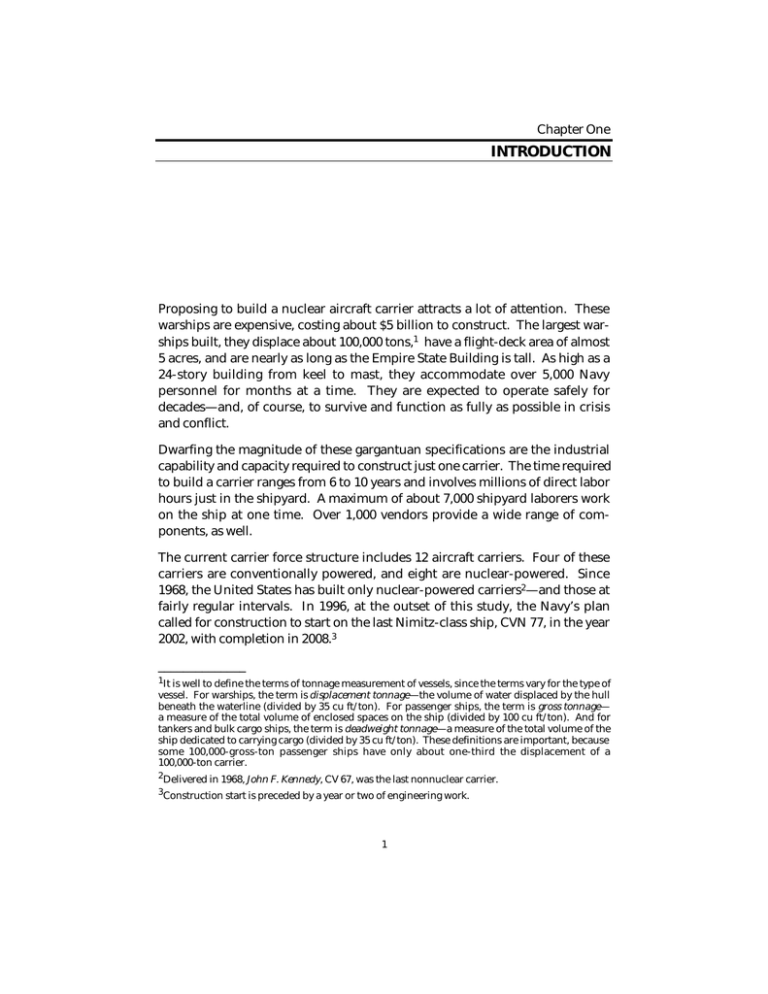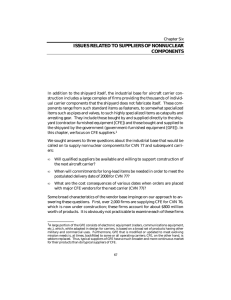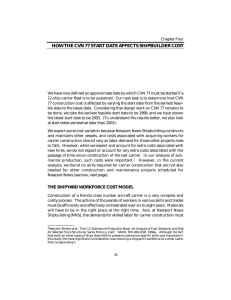INTRODUCTION
advertisement

Chapter One INTRODUCTION Proposing to build a nuclear aircraft carrier attracts a lot of attention. These warships are expensive, costing about $5 billion to construct. The largest warships built, they displace about 100,000 tons,1 have a flight-deck area of almost 5 acres, and are nearly as long as the Empire State Building is tall. As high as a 24-story building from keel to mast, they accommodate over 5,000 Navy personnel for months at a time. They are expected to operate safely for decades—and, of course, to survive and function as fully as possible in crisis and conflict. Dwarfing the magnitude of these gargantuan specifications are the industrial capability and capacity required to construct just one carrier. The time required to build a carrier ranges from 6 to 10 years and involves millions of direct labor hours just in the shipyard. A maximum of about 7,000 shipyard laborers work on the ship at one time. Over 1,000 vendors provide a wide range of components, as well. The current carrier force structure includes 12 aircraft carriers. Four of these carriers are conventionally powered, and eight are nuclear-powered. Since 1968, the United States has built only nuclear-powered carriers2—and those at fairly regular intervals. In 1996, at the outset of this study, the Navy’s plan called for construction to start on the last Nimitz-class ship, CVN 77, in the year 2002, with completion in 2008.3 ______________ 1 It is well to define the terms of tonnage measurement of vessels, since the terms vary for the type of vessel. For warships, the term is displacement tonnage—the volume of water displaced by the hull beneath the waterline (divided by 35 cu ft/ton). For passenger ships, the term is gross tonnage— a measure of the total volume of enclosed spaces on the ship (divided by 100 cu ft/ton). And for tankers and bulk cargo ships, the term is deadweight tonnage—a measure of the total volume of the ship dedicated to carrying cargo (divided by 35 cu ft/ton). These definitions are important, because some 100,000-gross-ton passenger ships have only about one-third the displacement of a 100,000-ton carrier. 2 Delivered in 1968, John F. Kennedy, CV 67, was the last nonnuclear carrier. 3 Construction start is preceded by a year or two of engineering work. 1 2 The U.S. Aircraft Carrier Industrial Base That schedule results in a 7-year gap since construction started on CVN 76, which was authorized in fiscal year 1995 (FY95). This gap exceeds any construction interval between individual carriers in the past 30 years. The longest previous gap was six years, between USS Carl Vinson (CVN 70, 1974) and USS Theodore Roosevelt (CVN 71, 1980). Theodore Roosevelt required more manhours to complete than did earlier carriers, in part because of turnover and skill deterioration of the workforce.4 It produced higher vendor costs than any other carrier of the Nimitz class built to date. The Navy was concerned that a longer gap might cause such costs to be accrued again. At the same time, it had to consider the following: • The debate about postponing the construction start of CVN 77 for a few years • The possibility that budget constraints might cause construction of CVN 77 to be bypassed completely to make way for the first ship of the next class, designated CVX, which is now scheduled for a construction start in 2006 • The fact that the average age of U.S. conventional carriers in 2008 will be 44 years. As these ships age, they become increasingly expensive and difficult to maintain. Motivated by these considerations, the Navy asked RAND to perform an independent, quantitative analysis of the aircraft carrier industrial base, focusing on CVN 77. We sought to determine whether the industrial base was adequate to support future carrier production. Additionally, we sought answers to the following questions: 1. What constraints does the need to meet carrier force requirements place on start dates for CVN 77? To answer this question, we graphically demonstrate the relations among fleet size, ship retirement age, and the schedule of newship construction (in Chapter Three). 2. Of those start dates responsive to force requirements, which permits the most economical carrier construction? Do longer gaps entail risks? Here, we report the results of a mathematical model that determines, for any start date, the least-cost shipyard workforce profile, given the other work planned for the yard building the carrier (in Chapter Four). 3. What are the implications of different start dates for the survival of vendors supplying carrier components to the shipyard? What are the implications for ______________ 4 Moving carrier production to another part of the shipyard, a change in production sequence, and an accelerated production schedule also contributed to the high man-hours. Introduction 3 the cost of those components? We answer these questions separately for the suppliers of nuclear and nonnuclear components (in Chapters Five and Six, respectively). 4. Are there any production processes or technologies not now employed in Navy shipbuilding that could permit significant savings in carrier life-cycle costs? If so, some research and development will be required to adapt such processes and technologies to aircraft-carrier construction and operation. How much R&D do the potential savings justify? We found the answer to the first question through interviews with manufacturers of large, complex ships for the commercial sector. We derived the second answer by estimating key maintenance and personnel costs, then conservatively hypothesizing a certain percentage savings (in Chapter Seven). Of course, no projection of future costs and other consequences can be made with certainty. The implications of varying CVN 77’s start date are mediated by the timing of construction, maintenance, and retirement of other warships. For that timing, we have sought consistency with current Navy plans, because they appear at least as likely as any other future and because doing so should be of greatest utility to acquisition planners in the Navy and elsewhere. Assumptions specific to the various elements of our analysis are taken up in the relevant chapters. We stress here that if the flow of work through the shipyard and vendors varies significantly from that now planned, the results of this analysis could also vary, not only in the size of the predicted effects but also in their direction.



